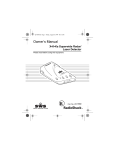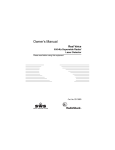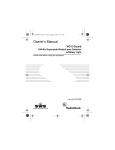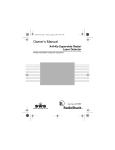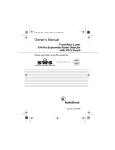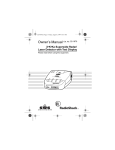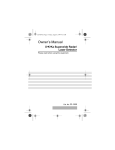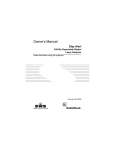Download Radio Shack XoKoKa Superwide Owner`s manual
Transcript
22-1681.fm Page 1 Wednesday, July 14, 1999 1:04 PM Owner’s Manual Safety Warning System X•K•Ka Superwide Radar/ Laser Detector Please read before using this equipment. Cat. No. 22-1681 22-1681.fm Page 2 Wednesday, July 14, 1999 1:04 PM FEATURES Your RadioShack Safety Warning System X•K•Ka Superwide Radar/Laser Detector can alert you to all known police traffic radar and laser systems. It receives X-, K-, and Ka-band radar signals and also detects both the instant-on and laser systems many police departments use to measure vehicle speed. Plus, your detector can give you advance warning of potential road hazards by detecting signals from transmitters that broadcast Safety Warning System alerts. Your detector has many useful features, including: VG-2 Protection — makes your detector invisible to the VG-2 radar-detector detector when it senses VG-2 operation. X-, K-, Ka-Band, and Laser Signal Detection — warns you when it detects signals from traffic radar or laser devices. Different tones sound to let you know the type of signal received. Safety Warning System Detection — alerts you to the presence of potential road hazards and emergency vehicles signalled by a Safety Warning System transmission. 360° Detection — detects laser signals from both the front and the rear of your vehicle. 1997, 1998 Tandy Corporation. All Rights Reserved. RadioShack is a registered trademark used by Tandy Corporation. FAST is a trademark used by Tandy Corporation. Safety Warning System and SWS are trademarks of Safety Warning System LLC. InstaClear is a registered trademark used by Ford Motor Company. ElectriClear is a registered trademark used by Libbey, Owens, Ford, and Delco-Remy. 2 22-1681.fm Page 3 Wednesday, July 14, 1999 1:04 PM City/Highway Modes — let you minimize alerts when you are in areas that have false radar sources. FAST (False Alert Suppression Technology) — helps prevent false alarms caused by non-traffic radar sources. Auto Quiet — lets you set the radar detector to give you a fullvolume alert for about 5 seconds, then reduce its alert to minimum volume. Your radar/laser detector includes the following items: • Coiled Power Cord • Windshield Bracket with Suction Cups • Hook and Loop Fastener We recommend you record your detector’s serial number here. The number is on the detector’s bottom panel. Serial Number: _________________________________ Important: Some areas have laws regulating the use of radar detectors. Check with your local law enforcement agency about the laws in your area. 3 22-1681.fm Page 4 Wednesday, July 14, 1999 1:04 PM CONTENTS A Quick Look . . . . . . . . . . . . . . . . . . . . . . . . . . . . . . . . . . . . 5 Installation . . . . . . . . . . . . . . . . . . . . . . . . . . . . . . . . . . . . . . 7 Mounting Guidelines . . . . . . . . . . . . . . . . . . . . . . . . . . . 7 Hook-and-Loop Tape Mounting . . . . . . . . . . . . . . . . . . . 8 Windshield Mounting . . . . . . . . . . . . . . . . . . . . . . . . . . . 9 Connecting Power . . . . . . . . . . . . . . . . . . . . . . . . . . . . 11 Operation . . . . . . . . . . . . . . . . . . . . . . . . . . . . . . . . . . . . . . Turning the Detector On and Off . . . . . . . . . . . . . . . . . Adjusting the Volume . . . . . . . . . . . . . . . . . . . . . . . . . . Demonstrating Alerts . . . . . . . . . . . . . . . . . . . . . . . . . . Muting Alerts . . . . . . . . . . . . . . . . . . . . . . . . . . . . . . . . Using Auto Quiet . . . . . . . . . . . . . . . . . . . . . . . . . . . . . Selecting the City and Highway Modes . . . . . . . . . . . . Setting the VG-2 Option . . . . . . . . . . . . . . . . . . . . . . . . Receiving and Identifying Alert Signals . . . . . . . . . . . . Resetting the Detector . . . . . . . . . . . . . . . . . . . . . . . . . 12 12 12 13 13 14 14 15 16 17 Troubleshooting . . . . . . . . . . . . . . . . . . . . . . . . . . . . . . . . 18 Replacing the Fuse . . . . . . . . . . . . . . . . . . . . . . . . . . . 20 4 22-1681.fm Page 5 Wednesday, July 14, 1999 1:04 PM A QUICK LOOK 1. Rear Laser Detection Lens — receives incoming laser signals from the rear. 2. PWR (Power/Volume) Button — turns the detector on and off and lets you adjust the volume. 3. MUTE Button — press before a radar/laser signal is detected to reduce the level of audio alerts that sound when there is a signal. Press after a signal is detected to silence the alert, but still have visual alerts to keep you informed. 4. CITY Button — reduces false alerts typically encountered in urban driving areas. Also works with the MUTE button to turn the VG-2 option on or off. 5 22-1681.fm Page 6 Wednesday, July 14, 1999 1:04 PM 5. Band Identifying LEDs — identify the type of radar detected. 6. Digital Display — provides distinct visual confirmation of signal strength and indicates the selected operating modes. 7. Speaker — sounds distinct audio alerts. 8. Power Jack — the power cable plugs in here. 9. Bracket Release Button — lets you quickly remove the detector’s bracket. 12 10 11 10. Front Laser Detection Lens — receives incoming laser signals from the front. 11. Radar Detection Antenna — receives incoming radar signals. 12. Mounting Bracket Slot — holds the windshield mounting bracket. 6 22-1681.fm Page 7 Wednesday, July 14, 1999 1:04 PM INSTALLATION MOUNTING GUIDELINES Follow these guidelines when selecting a location. • Choose a location that does not block the driver’s view of the road. • Mount the detector in a level position with a clear view to both the front and rear. • The detector’s view of the road must not be blocked by any metal object. • Some vehicles have InstaClear or ElectriClear defogging windshields, which have metal coatings that block signals. General Motor’s APV vans have a solar shield that keeps the vehicle cooler during the summer, but also blocks signals. A detector installed in a vehicle with any of these features will probably not detect a signal. • Since window tinting reduces the received strength of laser signals, you should not mount the detector behind any tinted glass. • Do not mount the detector where the driver or a passenger might hit it in a sudden stop or accident. Caution: Whichever mounting method you choose, place the detector out of view when you leave the vehicle. This keeps the detector out of sight of thieves and prevents exposing it to extremely high temperatures, which can temporarily impair performance. 7 22-1681.fm Page 8 Wednesday, July 14, 1999 1:04 PM HOOK-AND-LOOP TAPE MOUNTING For some dashboards, the hook-and-loop tape included with your detector might be best for mounting. Follow these steps to use the hook-and-loop tape. 1. Use a damp cloth to clean the bottom of the detector and the dashboard. Let both surfaces dry. Note: The tape’s adhesive might not stick to a surface treated with vinyl cleaner or protectant. 2. Remove the tape’s backing and stick the tape to the bottom of the detector. Note: Do not place the hook-and-loop tape over the detector’s serial number. Serial Number Hook-and-Loop Tape On a curved dashboard, cut the supplied strip in half and use one strip on each side of the bottom of the detector. 3. Remove the backing from the other side of the tape and press the detector onto the dashboard. 8 22-1681.fm Page 9 Wednesday, July 14, 1999 1:04 PM WINDSHIELD MOUNTING The supplied suction-cup windshield bracket lets you easily mount the detector on the windshield. Caution: Do not use the bracket in a vehicle that has a plastic coating on the windshield designed to protect passengers during an accident. If you use the bracket on this type of windshield, you might permanently mar the windshield’s surface. 1. Align the groove in each suction cup with the slots in the windshield bracket and slide the suction cups out until they lock into place. illus of suction cup installation in windshield bracket 2. Clean the selected windshield area, position the bracket on the windshield, and press firmly on each suction cup to secure it in place. 3. Slide the detector onto the base plate until it snaps into place. 9 22-1681.fm Page 10 Wednesday, July 14, 1999 1:04 PM To level the detector, press the bracket release button to remove the detector from the bracket. Then bend the bracket. 10 illus of bracket release button location 22-1681.fm Page 11 Wednesday, July 14, 1999 1:04 PM CONNECTING POWER Caution: • Use only the supplied power cord. If your power cord is lost or damaged, you can order a replacement cord from your local RadioShack store. • Before plugging the power cord’s cigarette-lighter plug into your vehicle’s cigarette-lighter socket, make sure the plug’s tip is screwed firmly onto the plug. See “Replacing the Fuse” on Page 23 for more information about the cigarettelighter plug. • Unplug the power cord’s cigarette-lighter plug from your vehicle’s cigarette-lighter socket when you turn off the ignition. This prevents your vehicle’s battery from being drained if you leave the detector on when you turn off the ignition. Plug the supplied power cord’s barrel plug into the detector’s power jack. Then plug the cord’s cigarette-lighter plug into your vehicle’s cigarette-lighter socket. Note: If the detector does not operate when you turn it on, remove the cigarette-lighter plug from your vehicle’s socket and check the socket for ashes and other debris. Also check the fuse in the cigarette-lighter plug and your vehicle’s fuse block (see “Replacing the Fuse” on Page 23). 11 22-1681.fm Page 12 Wednesday, July 14, 1999 1:04 PM OPERATION TURNING THE DETECTOR ON AND OFF To turn on the detector, press PWR. The detector sounds a distinctive alert and displays the indicators for each alert type as a self test, in this order: Alert Type Audible Alert X High trill K Low steady Ka Medium warble Safety None Laser None VG-2 None Visual Alert 8 and yellow LED 8 and red LED 8 and yellow/red LEDs S. and red LED L – All features selected are stored in memory. Each time a button is pressed, one beep confirms the feature is on and two beeps confirm the feature is off. See “Receiving and Identifying Alert Signals” on Page 15 for more information about alerts. To turn off the detector, press PWR. ADJUSTING THE VOLUME To adjust the detector’s volume, hold down PWR until the volume reaches the desired level, 1–4 (1 is the lowest level). 12 22-1681.fm Page 13 Wednesday, July 14, 1999 1:04 PM DEMONSTRATING ALERTS To familiarize yourself with the different alerts your detector sounds, you can run a demonstration. To start the demonstration, press and release MUTE and CITY at the same time with the detector turned on. The detector demonstrates the alerts for X, K, Ka, safety warning, laser, and VG-2, in that order. These audible and visual alerts sound and display: Alert Type Audible Alert Visual Alert X K Ka Safety Laser VG-2 High trill Low steady Medium warble Low ascending/descending High-low 4-tone ascending 3 and yellow LED 5 and red LED 7 and yellow/red LEDs S. and red LED L – To stop the demonstration, press PWR. MUTING ALERTS While a radar, laser, or safety warning alert is sounding, you can press MUTE to temporarily silence the detector for the current alert and any new alert that it receives within 20 seconds. Visual alerts are not affected. 13 22-1681.fm Page 14 Wednesday, July 14, 1999 1:04 PM USING AUTO QUIET Auto Quiet reduces the selected audio level to a minimum level about 5 seconds after it detects a radar signal. The audio alert sounds at the minimum level for any new signal received within 20 seconds. VG-2 or laser alerts are not affected. To turn on Auto Quiet, press MUTE when the detector is not sounding an alert. The detector briefly displays A, then returns to H or C. To turn off Auto Quiet, press MUTE when the detector is not sounding an alert. SELECTING THE CITY AND HIGHWAY MODES Your detector’s City mode is designed to reduce annoying false alerts triggered by automatic door openers, intrusion alarms, and other devices that share frequencies with police radar. Note: City mode has no effect on laser or VG-2 operation. To select the City mode, press CITY once. The detector displays C. If the detector receives a weak speed/safety radar signal in City mode, it beeps twice, then remains quiet unless the signal becomes very strong. If the signal strength increases, the detector again beeps twice. 14 22-1681.fm Page 15 Wednesday, July 14, 1999 1:04 PM To cancel the City mode, press CITY a second time. The detector displays H. The highway mode provides maximum alert response for open-road driving. SETTING THE VG-2 OPTION VG-2 is a system used by some law enforcement agencies to detect the use of radar detectors in vehicles. The VG-2 system detects the weak radio signals used in radar detectors. Your radar detector can sense a VG-2 system and shift its operating frequencies out of the range detected by VG-2, making your radar detector essentially invisible to this system. To turn on the VG-2 option, hold down MUTE for 2 seconds. Press CITY to engage or cancel. – appears when the detection mode is engaged. Press PWR to exit. Notes: • Your detector does not detect speed radar when VG-2 has been detected. • If you want to use the VG-2 option, you must turn it on when you turn the detector on. 15 22-1681.fm Page 16 Wednesday, July 14, 1999 1:04 PM RECEIVING AND IDENTIFYING ALERT SIGNALS Your detector gives different audible and visual alerts for each signal. In addition, the alert tone pulse rate increases with signal strength and the detector displays a digit from 1 to 9 to indicate the signal strength (1 is weakest and 9 is strongest). When you detector senses instant-on radar, it sounds an intense, 3-second tone and the detector displays P. Safety Radar Alerts Your radar detector detects all safety radar including the new Safety Warning System. This system provides advanced warning of hazards and lets you respond appropriately to potentially dangerous conditions. Note: Not all areas have Safety Warning System transmitters. Your radar detector only alerts you to hazards if the area you are in has transmitters sending signals. When your radar detector encounters safety radar, it sounds a distinctive tone and displays the signal strength. In addition, your radar detector displays S. Laser Audio/Visual Alerts When your radar detector detects a laser signal from ahead or behind, the laser audio sounds and the radar detector displays L for as long as the signal is present (for a minimum of 3 seconds). 16 22-1681.fm Page 17 Wednesday, July 14, 1999 1:04 PM Any laser alert, regardless of duration, requires immediate action! If you are the targeted vehicle, a laser gun can often determine your speed within seconds after you receive an alert. However, if you are traveling near or behind the targeted vehicle and receive an alert, you should have time to respond. RESETTING THE DETECTOR The detector keeps the audio level, city/highway mode, mute mode, auto quiet mode, VG-2 option, and on or off setting in memory when power is removed. When you reapply power, it returns to these same settings. To reset the detector to its factory default settings, unplug the detector’s power cord from the cigarette-lighter socket, hold down PWR and MUTE, plug in the power cord, wait for it to beep twice, then release PWR and MUTE. The detector turns off the auto quiet and VG-2 option, returns to highway mode, and sets the volume to its maximum level. 17 22-1681.fm Page 18 Wednesday, July 14, 1999 1:04 PM TROUBLESHOOTING If you have problems operating your radar/laser detector, the suggestions in this section might help. If you cannot solve the problem after trying these suggestions, take your detector to your local RadioShack store for assistance. If the detector does not turn on: • Be sure all power connections are secure. • Check the fuse that controls power to the cigarette-lighter socket. See your vehicle’s owner’s manual. • Check the fuse in the cigarette-lighter plug. See “Replacing the Fuse” on Page 20. • The cigarette-lighter socket might be dirty. Clean it to give a good, clean connection. Caution: Do not place any metal object other than the cigarette lighter or a cigarette-lighter plug in the cigarette-lighter socket. Doing so could blow a fuse in your vehicle or cause the metal object to become very hot. If the detector gives a false alert when the vehicle hits bumps in the road: • Check the power connections. 18 22-1681.fm Page 19 Wednesday, July 14, 1999 1:04 PM If the detector gives a false alert when you use accessories such as power windows, motorized mirrors, brakes, and so on: • Check the vehicle’s electrical system, including the main battery cable and alternator connections. • Install a filter capacitor (1,000 µf, 35 volts, such as Cat. No. 272-1032) on the back of the cigarette-lighter socket, across the power connections. If the detector performs the power on self-test (see “Turning the Detector On and Off” on Page 12), but does not respond to radar signals when you see a police car: • A police car might not be equipped with radar, or might be using instant-on radar and not have the radar gun triggered (see the separate booklet Questions and Answers About Vehicle Speed Detection). • Police might be using VASCAR-type speed detection (see the separate booklet Questions and Answers About Vehicle Speed Detection). If the detector has poor laser detection range: • Be sure the laser detection lenses are not blocked. • Use lens-cleaning solution to clean the laser detection lenses and the windshield. 19 22-1681.fm Page 20 Wednesday, July 14, 1999 1:04 PM REPLACING THE FUSE If the detector stops operating, check the fuse in the DC power cord’s cigarette-lighter plug. If it has blown, follow these steps to replace it with a 2-Amp, 11/4 × 1/4 mm, fast-acting fuse (Cat. No. 270-1007). Caution: Using a fuse that does not meet these ratings or defeating the fuse protection can damage your detector or the vehicle’s electrical system. 1. Carefully unscrew the tip of the cigarette-lighter plug. 2. Remove the tip from the cigarette-lighter plug, then remove the old fuse. Note: Take care not to lose the spring inside the holder or the metal ring. 3. Replace the fuse. 4. Press the cigarette-lighter plug’s tip down into the body, then screw it back in. Caution: Be sure you press the cigarette-lighter plug’s tip down before screwing it in, or you might damage the plug. 20 22-1681.fm Page 21 Wednesday, July 14, 1999 1:04 PM NOTES 21 22-1681.fm Page 22 Wednesday, July 14, 1999 1:04 PM 22 22-1681.fm Page 23 Wednesday, July 14, 1999 1:04 PM One or more of the following patents apply: 4,315,261; 5,146,227; 5,379,456. Other patents pending. 23 22-1681.fm Page 24 Wednesday, July 14, 1999 1:04 PM Limited One-Year Warranty This product is warranted by RadioShack against manufacturing defects in material and workmanship under normal use for one (1) year from the date of purchase from RadioShack company-owned stores and authorized RadioShack franchisees and dealers. EXCEPT AS PROVIDED HEREIN, RadioShack MAKES NO EXPRESS WARRANTIES AND ANY IMPLIED WARRANTIES, INCLUDING THOSE OF MERCHANTABILITY AND FITNESS FOR A PARTICULAR PURPOSE, ARE LIMITED IN DURATION TO THE DURATION OF THE WRITTEN LIMITED WARRANTIES CONTAINED HEREIN. EXCEPT AS PROVIDED HEREIN, RadioShack SHALL HAVE NO LIABILITY OR RESPONSIBILITY TO CUSTOMER OR ANY OTHER PERSON OR ENTITY WITH RESPECT TO ANY LIABILITY, LOSS OR DAMAGE CAUSED DIRECTLY OR INDIRECTLY BY USE OR PERFORMANCE OF THE PRODUCT OR ARISING OUT OF ANY BREACH OF THIS WARRANTY, INCLUDING, BUT NOT LIMITED TO, ANY DAMAGES RESULTING FROM INCONVENIENCE, LOSS OF TIME, DATA, PROPERTY, REVENUE, OR PROFIT OR ANY INDIRECT, SPECIAL, INCIDENTAL, OR CONSEQUENTIAL DAMAGES, EVEN IF RadioShack HAS BEEN ADVISED OF THE POSSIBILITY OF SUCH DAMAGES. Some states do not allow the limitations on how long an implied warranty lasts or the exclusion of incidental or consequential damages, so the above limitations or exclusions may not apply to you. In the event of a product defect during the warranty period, take the product and the RadioShack sales receipt as proof of purchase date to any RadioShack store. RadioShack will, at its option, unless otherwise provided by law: (a) correct the defect by product repair without charge for parts and labor; (b) replace the product with one of the same or similar design; or (c) refund the purchase price. All replaced parts and products, and products on which a refund is made, become the property of RadioShack. New or reconditioned parts and products may be used in the performance of warranty service. Repaired or replaced parts and products are warranted for the remainder of the original warranty period. You will be charged for repair or replacement of the product made after the expiration of the warranty period. This warranty does not cover: (a) damage or failure caused by or attributable to acts of God, abuse, accident, misuse, improper or abnormal usage, failure to follow instructions, improper installation or maintenance, alteration, lightning or other incidence of excess voltage or current; (b) any repairs other than those provided by a RadioShack Authorized Service Facility; (c) consumables such as fuses or batteries; (d) cosmetic damage; (e) transportation, shipping or insurance costs; or (f) costs of product removal, installation, set-up service adjustment or reinstallation. This warranty gives you specific legal rights, and you may also have other rights which vary from state to state. RadioShack Customer Relations, Dept. W, 100 Throckmorton St., Suite 600, Fort Worth, TX 76102 We Service What We Sell 3/97 RadioShack A Division of Tandy Corporation Fort Worth, Texas 76102 9/98 Printed in the U.S.A.
























